Photocatalytic Degradation of Tetracycline by Supramolecular Materials Constructed with Organic Cations and Silver Iodide
Abstract
1. Introduction
2. Results and Discussion
2.1. Description of Crystal Structures of {[(L1)·(Ag4I7)]·CH3CN} (1) and {[(L2)·(Ag4I7)]·CH3CN} (2)
2.2. TG–DTA Analysis
2.3. Semiconductor Properties of Compounds 1 and 2
2.4. Catalytic Performance of the Degradation of TC with Compounds 1 and 2
2.5. Effect of pH Solution on TC Degradation
2.6. Effect of the Amount of Catalyst on TC Degradation
2.7. Effects of Anions on Photocatalysis and Catalytic Mechanism
2.8. Photocatalyst Recyclability
3. Materials and Methods
3.1. Materials
3.2. Synthesis of Compounds
3.2.1. The Synthesis of {[(L1)·(Ag4I7)]·CH3CN} 1
3.2.2. The Synthesis of {[(L2)·(Ag4I7)]·CH3CN} 2
3.3. Methods for Characterizing Compounds
4. Conclusions
Author Contributions
Funding
Acknowledgments
Conflicts of Interest
References
- Salipira, K.L.; Mamba, B.B.; Krause, R.W.; Malefetse, T.J.; Durbach, S.H. Carbon nanotubes and cyclodextrin polymers for removing organic pollutants from water. Environ. Chem. Lett. 2006, 5, 13–17. [Google Scholar] [CrossRef][Green Version]
- Wojtyla, S.; Baran, T. Insight on doped ZnS and its activity towards photocatalytic removing of Cr(VI) from wastewater in the presence of organic pollutants. Mater. Chem. Phys. 2018, 212, 103–112. [Google Scholar] [CrossRef]
- Zhuang, H.M.; Zhang, W.M.; Wang, L.; Zhu, Y.Y.; Xi, Y.Y.; Lin, X.F. Vapor Deposition-Prepared MIL-100(Cr)- and MIL-101(Cr)-Supported Iron Catalysts for Effectively Removing Organic Pollutants from Water. ACS Omega 2021, 63, 25311–25322. [Google Scholar] [CrossRef]
- Liu, J.; Deng, W.J.; Ying, G.G.; Tsang, E.P.K.; Hong, H.C. Occurrence and distribution of antibiotics in surface water. Ecotoxicology 2022, 31, 1111–1119. [Google Scholar] [CrossRef]
- Couch, M.; Agga, G.E.; Kasumba, J.; Parekh, R.R.; Loughrin, J.H.; Conte, E.D. Abundances of Tetracycline Resistance Genes and Tetracycline Antibiotics during Anaerobic Digestion of Swine Waste. J. Environ. Qual. 2019, 48, 171–178. [Google Scholar] [CrossRef] [PubMed]
- Li, P.Y.; Rao, D.M.; Wang, Y.M.; Hu, X.R. Adsorption characteristics of polythiophene for tetracyclines and determination of tetracyclines in fish and chicken manure by solid phase extraction-HPLC method. Microchem. J. 2021, 173, 106935. [Google Scholar] [CrossRef]
- Du, L.F.; Liu, W.K. Occurrence, fate, and ecotoxicity of antibiotics in agro-ecosystems: A review. Agron. Sustain. Dev. 2011, 32, 309–327. [Google Scholar] [CrossRef]
- Kuppusamy, S.; Kakarla, D.; Venkateswarlu, K.; Megharaj, M.; Yoon, Y.E.; Lee, Y.B. Veterinary antibiotics (VAs) contamination as a global agro-ecological issue: A critical view. Agric. Ecosyst. Environ. 2018, 257, 47–59. [Google Scholar] [CrossRef]
- Zhou, Y.; Yang, Q.; Zhang, D.N.; Gan, N.; Li, Q.P.; Cuan, J. Detection and removal of antibiotic tetracycline in water with a highly stable luminescent MOF. Sens. Actuators B Chem. 2018, 262, 137–143. [Google Scholar] [CrossRef]
- Li, J.; Wang, X.X.; Zhao, G.X.; Chen, C.L.; Chai, Z.F.; Alsaedi, A.; Hayat, T.; Wang, X.K. Metal–organic framework-based materials: Superior adsorbents for the capture of toxic and radioactive metal ions. Chem. Soc. Rev. 2018, 47, 2322–2356. [Google Scholar] [CrossRef]
- Zhao, G.X.; Huang, X.B.; Tang, Z.W.; Huang, Q.F.; Niu, F.L.; Wang, X.K. Polymer-based nanocomposites for heavy metal ions removal from aqueous solution: A review. Polym. Chem. 2018, 9, 3562–3582. [Google Scholar] [CrossRef]
- Fu, S.F.; Chen, K.Q.; Zou, H.; Xu, J.X.; Zheng, Y.; Wang, Q.F. Using calcium peroxide (CaO2) as a mediator to accelerate tetracycline removal and improve methane production during co-digestion of corn straw and chicken manure. Energy Convers. Manag. 2018, 172, 588–594. [Google Scholar] [CrossRef]
- Oturan, N.; Wu, J.; Zhang, H.; Sharma, V.K.; Oturan, M.A. Electrocatalytic destruction of the antibiotic tetracycline in aqueous medium by electrochemical advanced oxidation processes: Effect of electrode materials. Appl. Catal. B 2013, 140, 92–97. [Google Scholar] [CrossRef]
- Yu, L.L.; Cao, W.; Wu, S.C.; Yang, C.; Cheng, J.H. Removal of tetracycline from aqueous solution by MOF/graphite oxide pellets: Preparation, characteristic, adsorption performance and mechanism. Ecotoxicol. Environ. Saf. 2018, 164, 289–296. [Google Scholar] [CrossRef]
- Park, J.-A.; Nam, A.; Kim, J.-H.; Yun, S.-T.; Choi, J.-W.; Lee, S.-H. Blend-electrospun graphene oxide/Poly(vinylidene fluoride) nanofibrous membranes with high flux, tetracycline removal and anti-fouling properties. Chemosphere 2018, 207, 347–356. [Google Scholar] [CrossRef] [PubMed]
- Wang, X.J.; Qiao, X.Y.; Li, Z.Y.; Wei, D.H.; Niu, Y.Y. Influence of 4-cyanopyridinium multicationic isomers on the structure-property relationships of two-dimensional hybrid as photocatalyst for the degradation of organic dyes. Inorg. Chem. Commun. 2020, 119, 108126. [Google Scholar] [CrossRef]
- Li, H.P.; Dou, Z.; Chen, S.Q.; Hu, M.; Li, S.; Sun, H.M.; Jiang, Y.C.; Zhai, Q.G. Design of a Multifunctional Indium–Organic Framework: Fluorescent Sensing of Nitro Compounds, Physical Adsorption, and Photocatalytic Degradation of Organic Dyes. Inorg. Chem. 2019, 58, 11220–11230. [Google Scholar] [CrossRef]
- Deng, S.Q.; Mo, X.J.; Zheng, S.R.; Jin, X.; Gao, Y.; Cai, S.L.; Fan, J.; Zhang, W.G. Hydrolytically Stable Nanotubular Cationic Metal–Organic Framework for Rapid and Efficient Removal of Toxic Oxo-Anions and Dyes from Water. Inorg. Chem. 2019, 58, 2899–2909. [Google Scholar] [CrossRef]
- Ma, H.F.; Liu, Q.Y.; Wang, Y.L.; Yin, S.G. A Water-Stable Anionic Metal–Organic Framework Constructed from Columnar Zinc-Adeninate Units for Highly Selective Light Hydrocarbon Separation and Efficient Separation of Organic Dyes. Inorg. Chem. 2017, 56, 2919–2925. [Google Scholar] [CrossRef]
- Feng, L.Y.; Li, X.Y.; Chen, X.T.; Huang, Y.J.; Peng, K.S.; Huang, Y.X.; Yan, Y.Y.; Chen, Y.G. Pig manure-derived nitrogen-doped mesoporous carbon for adsorption and catalytic oxidation of tetracycline. Sci. Total Environ. 2019, 708, 135071. [Google Scholar] [CrossRef] [PubMed]
- Giammarco, J.; Mochalin, V.N.; Haeckel, J.; Gogotsi, Y. The adsorption of tetracycline and vancomycin onto nanodiamond with controlled release. J. Colloid Interface Sci. 2016, 468, 253–261. [Google Scholar] [CrossRef]
- Wang, D.; Jia, F.; Wang, H.; Chen, F.; Fang, Y.; Dong, W.; Zeng, G.; Li, X.; Yang, Q.; Yuan, X. Simultaneously efficient adsorption and photocatalytic degradation of tetracycline by Fe-based MOFs. J. Colloid Interface Sci. 2018, 519, 273–284. [Google Scholar] [CrossRef] [PubMed]
- Zhang, S.P.; Li, Y.K.; Shi, C.H.; Guo, F.Y.; He, C.Z.; Cao, Z.; Hu, J.; Cui, C.Z.; Liu, H.L. Induced-fit adsorption of diol-based porous organic polymers for tetracycline removal. Chemosphere 2018, 212, 937–945. [Google Scholar] [CrossRef]
- Dewil, R.; Mantzavinos, D.; Poulios, I.; Rodrigo, M.A. New perspectives for Advanced Oxidation Processes. J. Environ. Manag. 2017, 195, 93–99. [Google Scholar] [CrossRef]
- Babu, S.G.; Ashokkumar, M.; Neppolian, B. The Role of Ultrasound on Advanced Oxidation Processes. Top. Curr. Chem. 2016, 374, 75. [Google Scholar] [CrossRef] [PubMed]
- Bavasso, I.; Montanaro, D.; Petrucci, E. Ozone-based electrochemical advanced oxidation processes. Curr. Opin. Electrochem. 2022, 34, 101017. [Google Scholar] [CrossRef]
- Wang, J.L.; Zhuan, R. Degradation of antibiotics by advanced oxidation processes: An overview. Sci. Total Environ. 2019, 701, 135023. [Google Scholar] [CrossRef] [PubMed]
- De Filpo, G.; Pantuso, E.; Mashin, A.I.; Baratta, M.; Nicoletta, F.P. WO3/Buckypaper Membranes for Advanced Oxidation Processes. Membranes 2020, 45, 157. [Google Scholar] [CrossRef]
- Bethi, B.; Sonawane, S.H.; Bhanvase, B.A.; Gumfekar, S.P. Nanomaterials-based advanced oxidation processes for wastewater treatment: A review. Chem. Eng. Process. 2016, 109, 178–189. [Google Scholar] [CrossRef]
- Dai, Q.Z.; Zhou, M.H.; Lei, L.C.; Zhang, X.W. A novel advanced oxidation process—Wet electro-catalytic oxidation for high concentrated organic wastewater treatment. Sci. Bull. 2007, 52, 1724–1727. [Google Scholar] [CrossRef]
- Wang, X.Y.; Li, S.N.; Chen, P.; Li, F.X.; Hu, X.M.; Hua, T. Photocatalytic and antifouling properties of TiO2-based photocatalytic membranes. Mater. Today Chem. 2021, 23, 100650. [Google Scholar] [CrossRef]
- Koe, W.S.; Lee, J.W.; Chong, W.C.; Pang, Y.L.; Sim, L.C. An overview of photocatalytic degradation: Photocatalysts, mechanisms, and development of photocatalytic membrane. Environ. Sci. Pollut. Res. 2019, 27, 2522–2565. [Google Scholar] [CrossRef] [PubMed]
- Chang, P.; Wang, Y.H.; Wang, Y.T.; Zhu, Y.Y. Current trends on In2O3 based heterojunction photocatalytic systems in photocatalytic application. Chem. Eng. J. 2022, 450, 137804. [Google Scholar] [CrossRef]
- Qiao, X.Y.; Wang, C.H.; Niu, Y.Y. N-Benzyl HMTA induced self-assembly of organic-inorganic hybrid materials for efficient photocatalytic degradation of tetracycline. J. Hazard. Mater. 2020, 391, 122121. [Google Scholar] [CrossRef] [PubMed]
- Wang, X.J.; Qiao, G.Y.; Zhu, G.H.; Li, J.; Guo, X.Y.; Liang, Y.; Niu, Y.Y. Preparation of 2D supramolecular material doping with TiO2 for degradation of tetracycline. Environ. Res. 2021, 202, 111689. [Google Scholar] [CrossRef]
- Zhou, C.H.; Gan, L.L.; Zhang, Y.Y.; Zhang, F.F.; Wang, G.Z.; Jin, L.; Geng, R.X. Review on supermolecules as chemical drugs. Sci. China Chem. 2009, 52, 415–458. [Google Scholar] [CrossRef]
- Vicens, J.; Vicens, Q. Emergences of supramolecular chemistry: From supramolecular chemistry to supramolecular science. J. Incl. Phenom. Macrocycl. Chem. 2011, 71, 251–274. [Google Scholar] [CrossRef]
- Lu, D.P.; Huang, Q.; Wang, S.D.; Wang, J.Y.; Huang, P.S.; Du, P.W. The Supramolecular Chemistry of Cycloparaphenylenes and Their Analogs. Front. Chem. 2019, 7, 668. [Google Scholar] [CrossRef]
- Leclercq, L.; Douyère, G.; Nardello-Rataj, V. Supramolecular Chemistry and Self-Organization: A Veritable Playground for Catalysis. Catalysts 2019, 9, 163. [Google Scholar] [CrossRef]
- Prins, L.J.; Reinhoudt, D.N.; Timmerman, P. Noncovalent Synthesis Using Hydrogen Bonding. Angew. Chem. Int. Ed. 2001, 40, 2382–2426. [Google Scholar] [CrossRef]
- Adams, H.; Hunter, C.A.; Lawson, K.R.; Perkins, J.; Spey, S.E.; Urch, C.J.; Sanderson, J.M. A supramolecular system for quantifying aromatic stacking interactions. Chem. Eur. J. 2002, 7, 4863–4877. [Google Scholar] [CrossRef]
- Müller-Dethlefs, K.; Hobza, P. Noncovalent interactions: A challenge for experiment and theory. Chem. Rev. 2001, 100, 143–168. [Google Scholar] [CrossRef]
- Badjić, J.D.; Nelson, A.; Cantrill, S.J.; Turnbull, W.B.; Stoddart, J.F. Multivalency and cooperativity in supramolecular chemistry. Acc. Chem. Res. 2005, 38, 723–732. [Google Scholar] [CrossRef]
- Philp, D.; Stoddart, J.F. Self-Assembly in Natural and Unnatural Systems. Angew. Chem. Int. Ed. 1996, 35, 1154–1196. [Google Scholar] [CrossRef]
- Fyfe, M.C.T.; Stoddart, J.F. Synthetic Supramolecular Chemistry. Acc. Chem. Res. 1997, 30, 393–401. [Google Scholar] [CrossRef]
- Elemans, J.A.A.W.; Rowan, A.E.; Nolte, R.J.M. Mastering molecular matter. Supramolecular architectures by hierarchical self-assembly. J. Mater. Chem. 2003, 13, 2661–2670. [Google Scholar] [CrossRef]
- Yu, G.C.; Chen, X.Y. Host-Guest Chemistry in Supramolecular Theranostics. Theranostics 2019, 9, 3041–3074. [Google Scholar] [CrossRef] [PubMed]
- Bickerton, L.E.; Johnson, T.G.; Kerckhoffs, A.; Langton, M.J. Supramolecular chemistry in lipid bilayer membranes. Chem. Sci. 2021, 12, 11252–11274. [Google Scholar] [CrossRef] [PubMed]
- Kwon, T.; Choi, J.W.; Coskun, A. Prospect for Supramolecular Chemistry in High-Energy-Density Rechargeable Batteries. Joule 2019, 3, 662–682. [Google Scholar] [CrossRef]
- Zhou, H.Y.; Yamada, T.; Kimizuka, N. Supramolecular Thermocells based on Thermo-Responsiveness of Host–Guest Chemistry. Bull. Chem. Soc. Jpn. 2021, 94, 1525–1546. [Google Scholar] [CrossRef]
- Savyasachi, A.J.; Kotova, O.; Shanmugaraju, S.; Bradberry, S.J.; Ó’Máille, G.M.; Gunnlaugsson, T. Supramolecular Chemistry: A Toolkit for Soft Functional Materials and Organic Particles. Chem 2017, 3, 764–811. [Google Scholar] [CrossRef]
- Düren, T.; Sarkisov, L.; Yaghi, O.M.; Snurr, R.Q. Design of new materials for methane storage. Langmuir 2005, 20, 2683–2689. [Google Scholar] [CrossRef] [PubMed]
- Fukuhara, G. Analytical supramolecular chemistry: Colorimetric and fluorimetric chemosensors. J. Photochem. Photobiol. C 2020, 42, 100340. [Google Scholar] [CrossRef]
- Zhang, L.-Y.; Zhao, X.-Y.; Wang, C.-M.; Yu, K.; Lv, J.-H.; Wang, C.-X.; Zhou, B.-B. The supercapacitor and photocatalytic supermolecule materials constructed by 4′4-pyridine and {PMo12O40}. J. Solid State Chem. 2022, 312, 123235. [Google Scholar] [CrossRef]
- Sabina, G.I.; Octavian, D.P.; Nicolae, G.; Madalina, T.; Simona, M.C.; Vasile, I.P.; Bogdan, C.; Elisabeth, E.J. Use of Photocatalytically Active Supramolecular Organic–Inorganic Magnetic Composites as Efficient Route to Remove β-Lactam Antibiotics from Water. Catalysts 2022, 12, 1044. [Google Scholar]
- Zhou, X.H.; Chen, Y.Y.; Wang, P.Y.; Xu, C.Y.; Yan, Q.S. Fabrication of AgI/BiPO4 n–n heterojunction photocatalyst for efficient degradation of organic pollutants. J. Mater. Sci. Mater. Electron. 2020, 31, 12638–12648. [Google Scholar] [CrossRef]
- Lu, J.R.; Yue, M.T.; Cui, W.Q.; Sun, C.H.; Liu, L. Supramolecular photocatalyst of perylene bisimide decorated with α-Fe2O3: Efficient photo-Fenton degradation of organic pollutants. Colloids Surf. A Physicochem. Eng. Asp. 2022, 655, 130222. [Google Scholar] [CrossRef]
- Bao, S.H.; Wu, S.S.; Huang, L.P.; Xu, X.; Xu, R.; Li, Y.G.; Liang, Y.R.; Yang, M.Y.; Yoon, D.K.; Lee, M.; et al. Supramolecular Nanopumps with Chiral Recognition for Moving Organic Pollutants from Water. ACS Appl. Mater. Interfaces 2019, 11, 31220–31226. [Google Scholar] [CrossRef]
- Wang, H.Y.; Hou, L.L.; Li, C.; Zhang, D.D.; Ma, P.T.; Wang, J.P.; Niu, J.Y. Synthesis, structure, and photocatalytic hydrogen evolution of a trimeric Nb/W addendum cluster. RSC Adv. 2017, 7, 36416–36420. [Google Scholar] [CrossRef]
- Cao, P.Y.; Zhang, Y.P.; Gao, D.; Chen, H.X.; Zhou, M.L.; He, Y.F.; Song, P.F.; Wang, R.M. Constructing nano-heterojunction of MOFs with crystal regrowth for efficient degradation of tetracycline under visible light. J. Alloys Compd. 2022, 904, 164061. [Google Scholar] [CrossRef]
- Abd El-Monaem, E.M.; Omer, A.M.; Khalifa, R.E.; Eltaweil, A.S. Floatable cellulose acetate beads embedded with flower-like zwitterionic binary MOF/PDA for efficient removal of tetracycline. J. Colloid Interface Sci. 2022, 620, 333–345. [Google Scholar] [CrossRef] [PubMed]
- Zhang, Y.; Duoerkun, G.; Shi, Z.; Cao, W.; Liu, T.; Liu, J.; Zhang, L.; Li, M.; Chen, Z. Construction of TiO2/Ag3PO4 nanojunctions on carbon fiber cloth for photocatalytically removing various organic pollutants in static or flowing wastewater. J. Colloid Interface Sci. 2020, 571, 213–221. [Google Scholar] [CrossRef] [PubMed]
- Wu, F.; Zhou, F.; Zhu, Z.; Zhan, S.; He, Q. Enhanced photocatalytic activities of Ag3PO4/GO in tetracycline degradation. Chem. Phys. Lett. 2019, 724, 90–95. [Google Scholar] [CrossRef]
- Eslami, A.; Bahrami, H.; Asadi, A.; Alinejad, A. Enhanced sonochemical degradation of tetracycline by sulfate radicals. Water Sci. Technol. 2016, 287, 131981. [Google Scholar] [CrossRef]
- Hu, L.X.; Ren, X.H.; Yang, M.; Guo, W.L. Facet-controlled activation of persulfate by magnetite nanoparticles for the degradation of tetracycline. Sep. Purif. Technol. 2020, 258, 118014. [Google Scholar] [CrossRef]
- Wu, X.F.; Wang, Y.J.; Song, L.J.; Su, J.Z.; Zhang, J.R.; Jia, Y.N.; Shang, J.L.; Nian, X.W.; Zhang, C.Y.; Sun, X.G. A yolk–shell Bi@void@SnO2 photocatalyst with enhanced tetracycline degradation. J. Mater. Sci. Mater. Electron. 2019, 30, 14987–14994. [Google Scholar] [CrossRef]
- Vladimir, A.; Anna, A.; Vadim, B.; Svetlana, K.; Varvara, V.; Daniil, K.; Madina, S.; Alexander, B.; Igor, F.; Roman, N.; et al. Fast Degradation of Tetracycline and Ciprofloxacin in Municipal Water under Hydrodynamic Cavitation/Plasma with CeO2 Nanocatalyst. Processes 2022, 10, 2063. [Google Scholar]
- Du, H.J.; Zhang, W.L.; Wang, C.H.; Niu, Y.Y.; Hou, H.W. A new nanocrystalline inorganic–organic hybrid exhibiting semiconducting properties and applications†. Dalton Trans. 2015, 45, 2624–2628. [Google Scholar] [CrossRef]
- Beatríz, G.-A.; Ramón, M.-M.; José, V.R.-L.; Félix, S.; Juan, S. Discrimination between ω-amino acids with chromogenic acyclic tripodal receptors functionalized with stilbazolium dyes. Tetrahedron Lett. 2008, 49, 1997–2001. [Google Scholar]
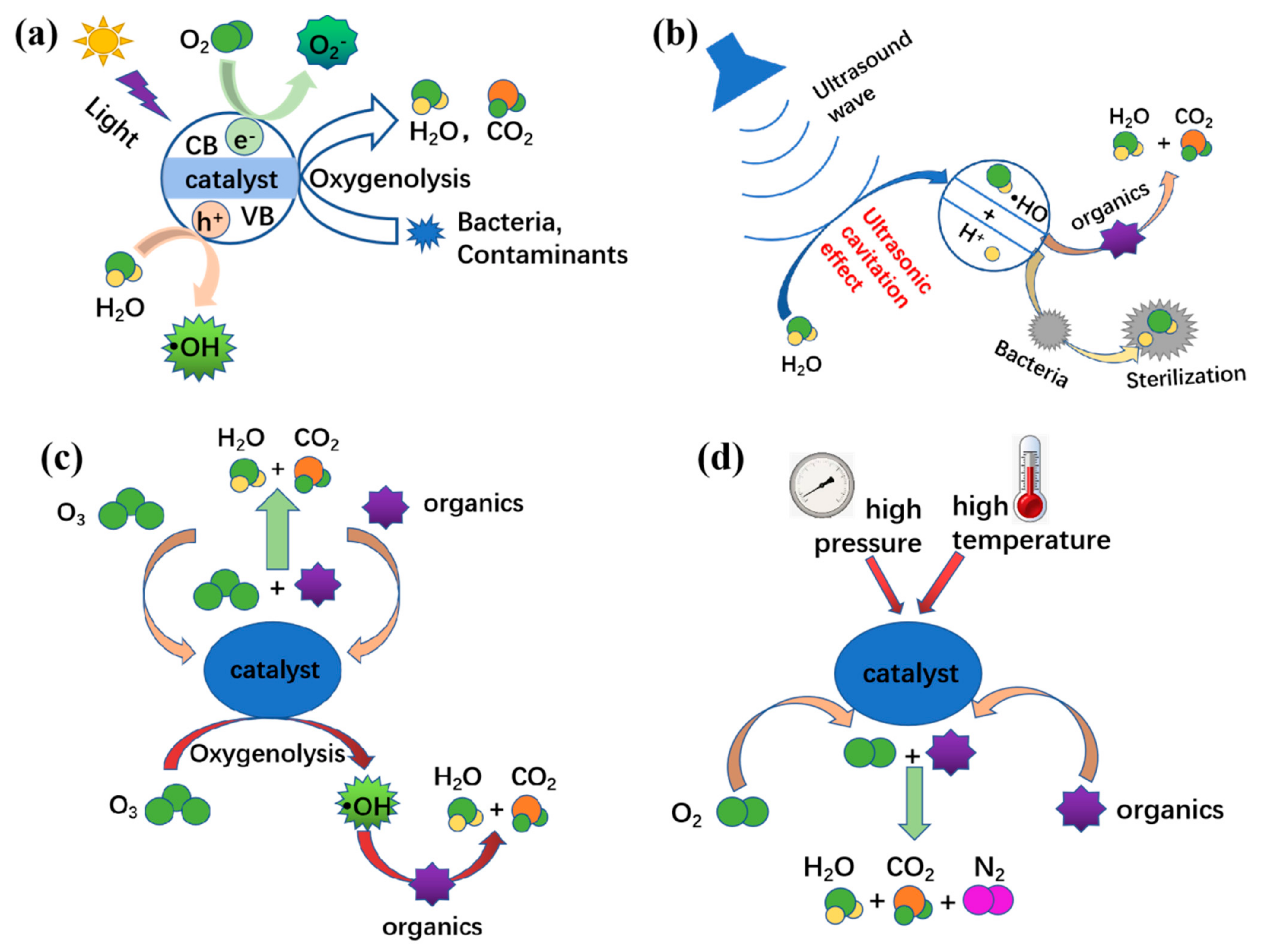

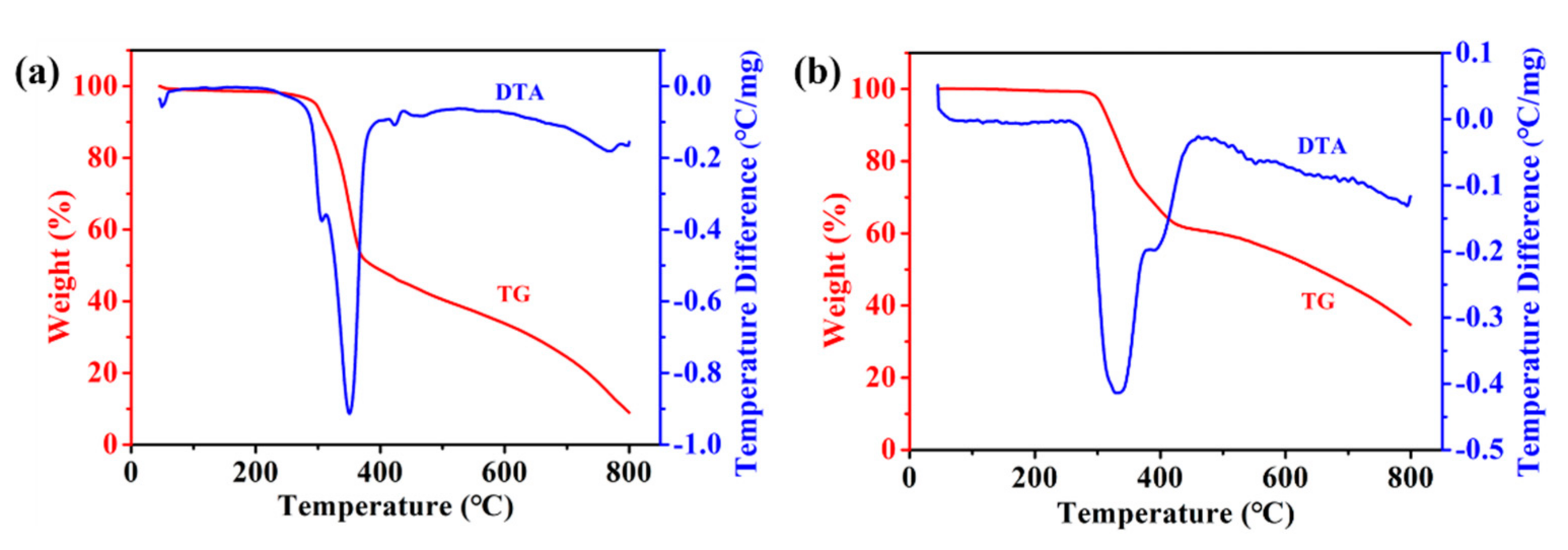
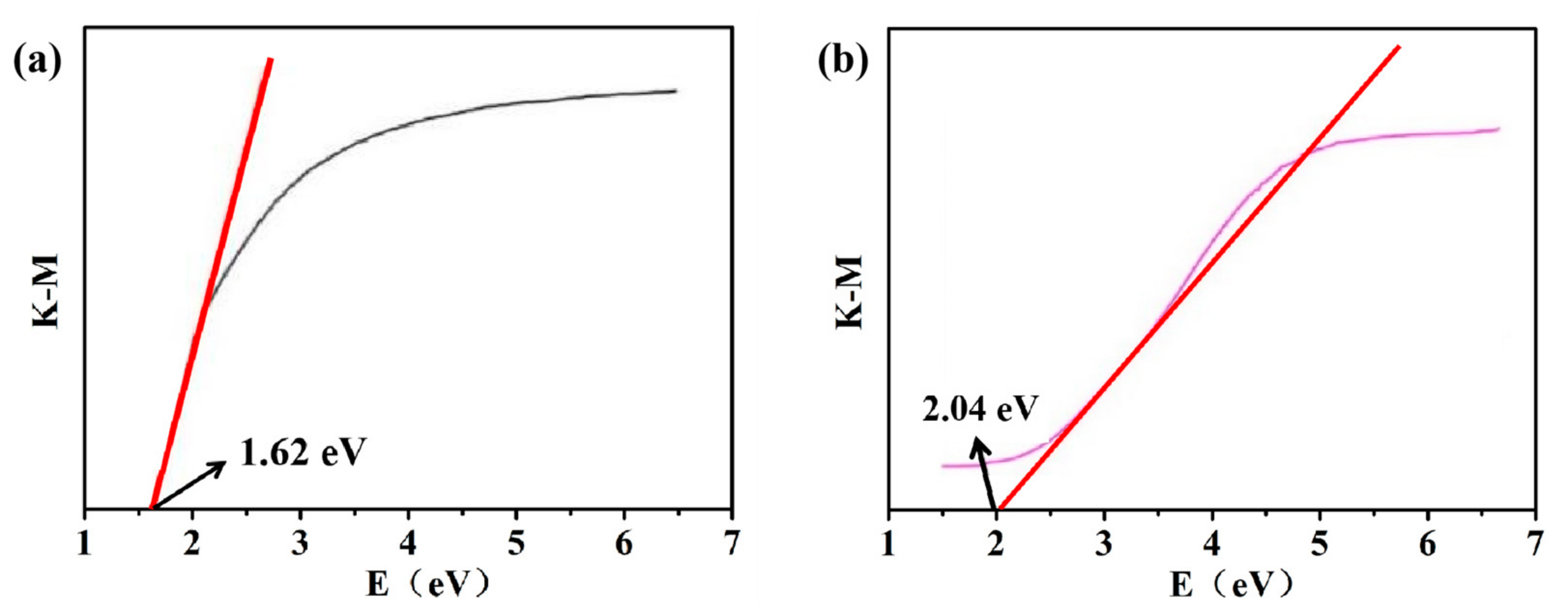
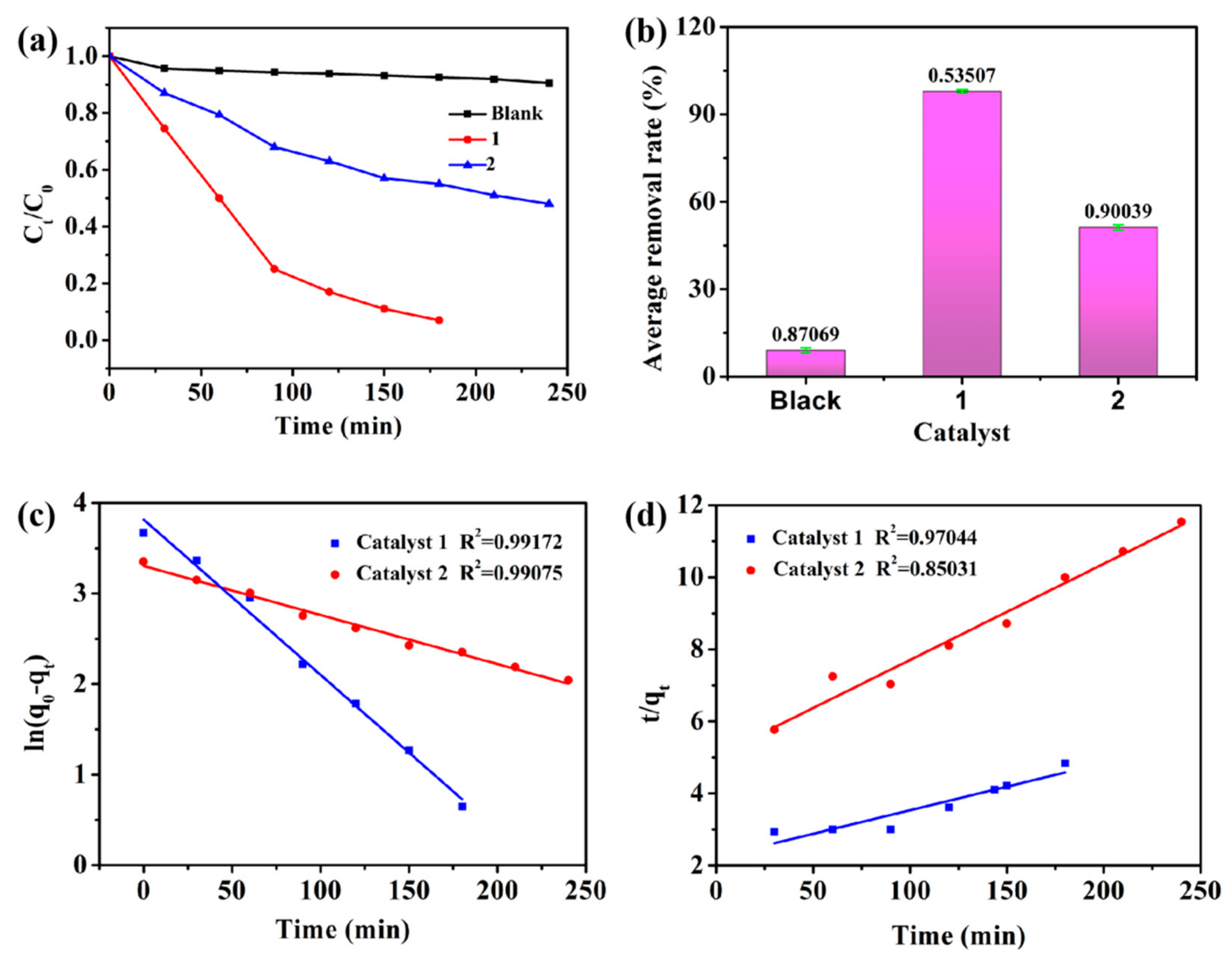


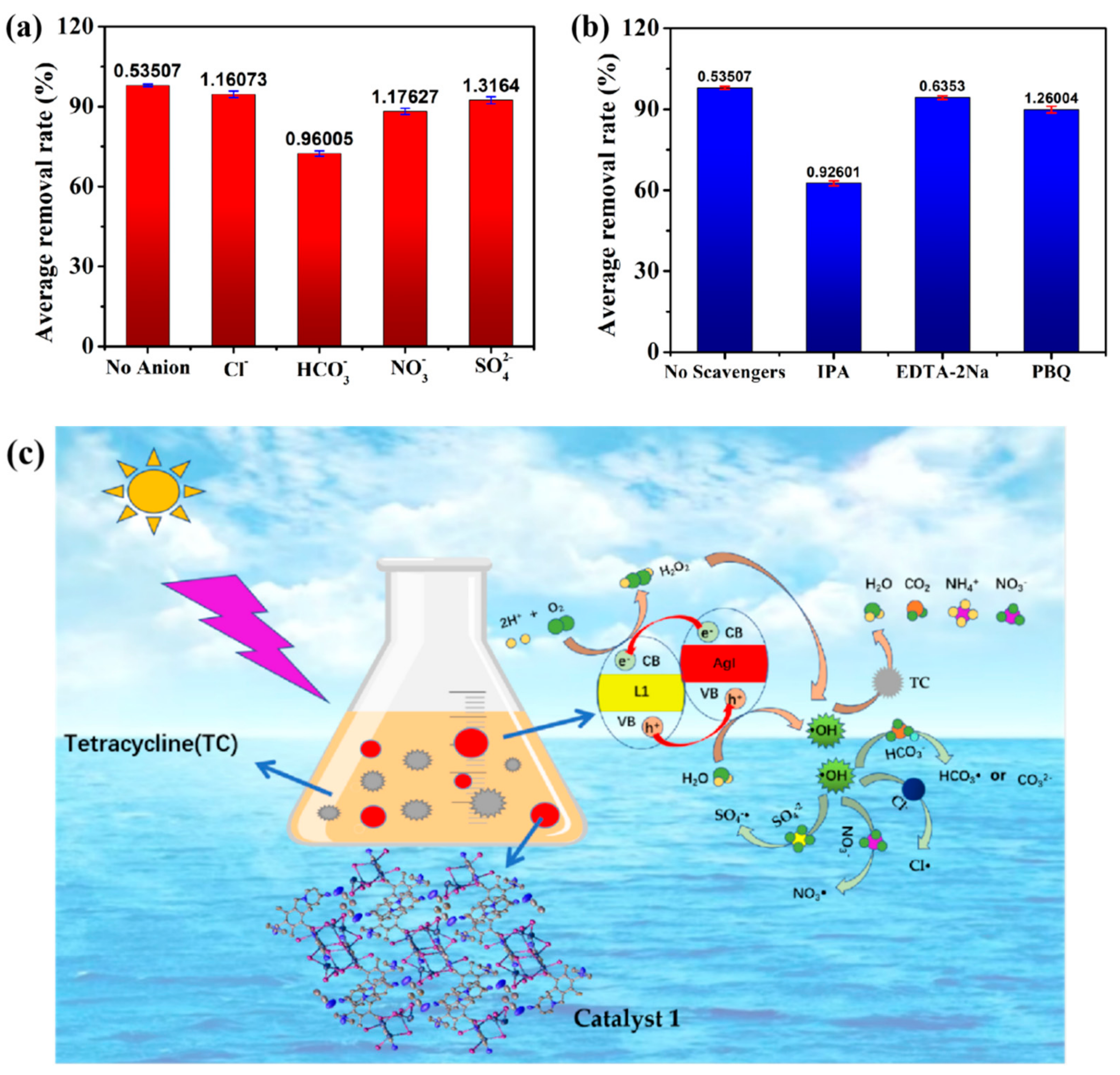
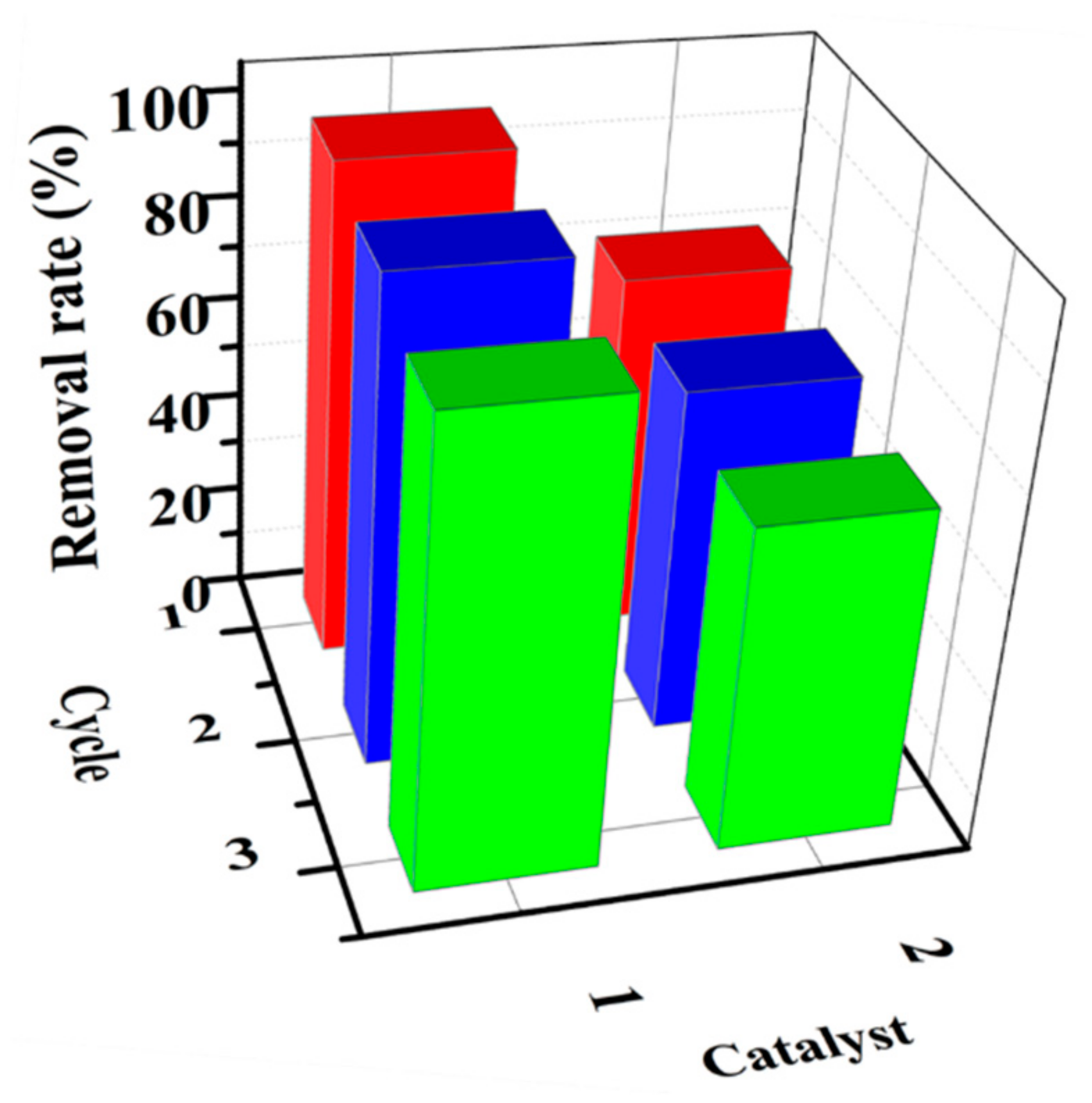
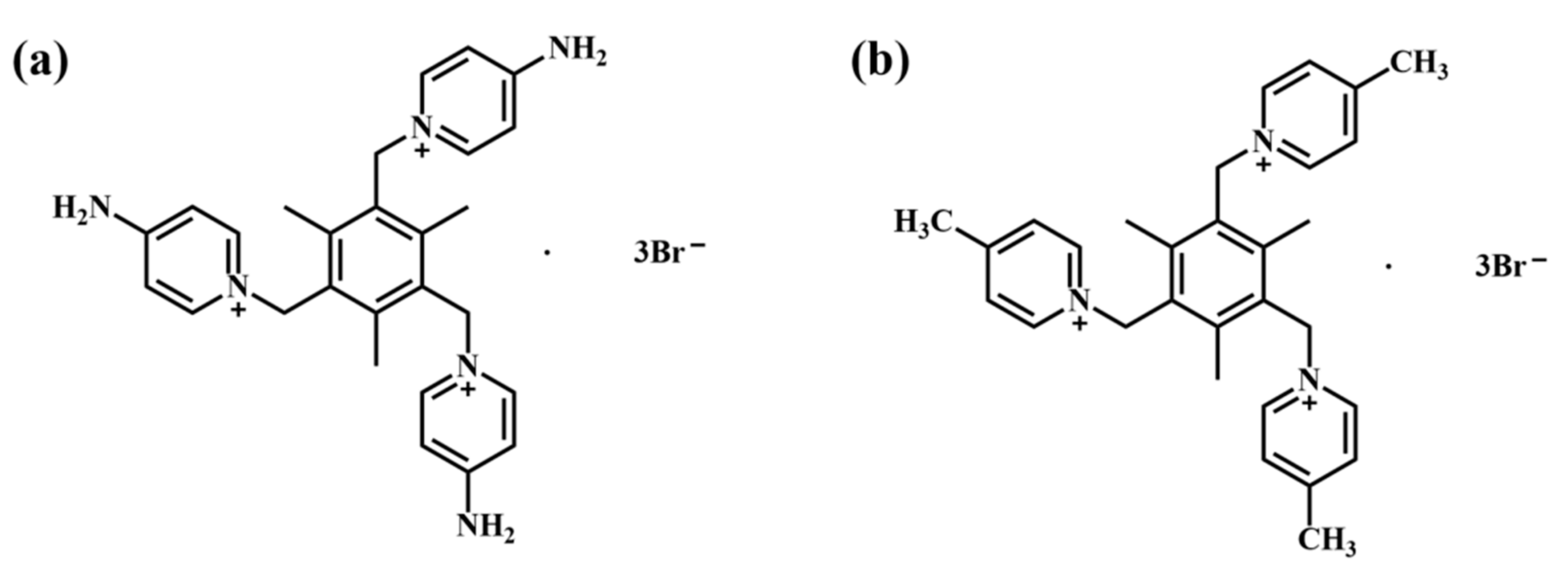
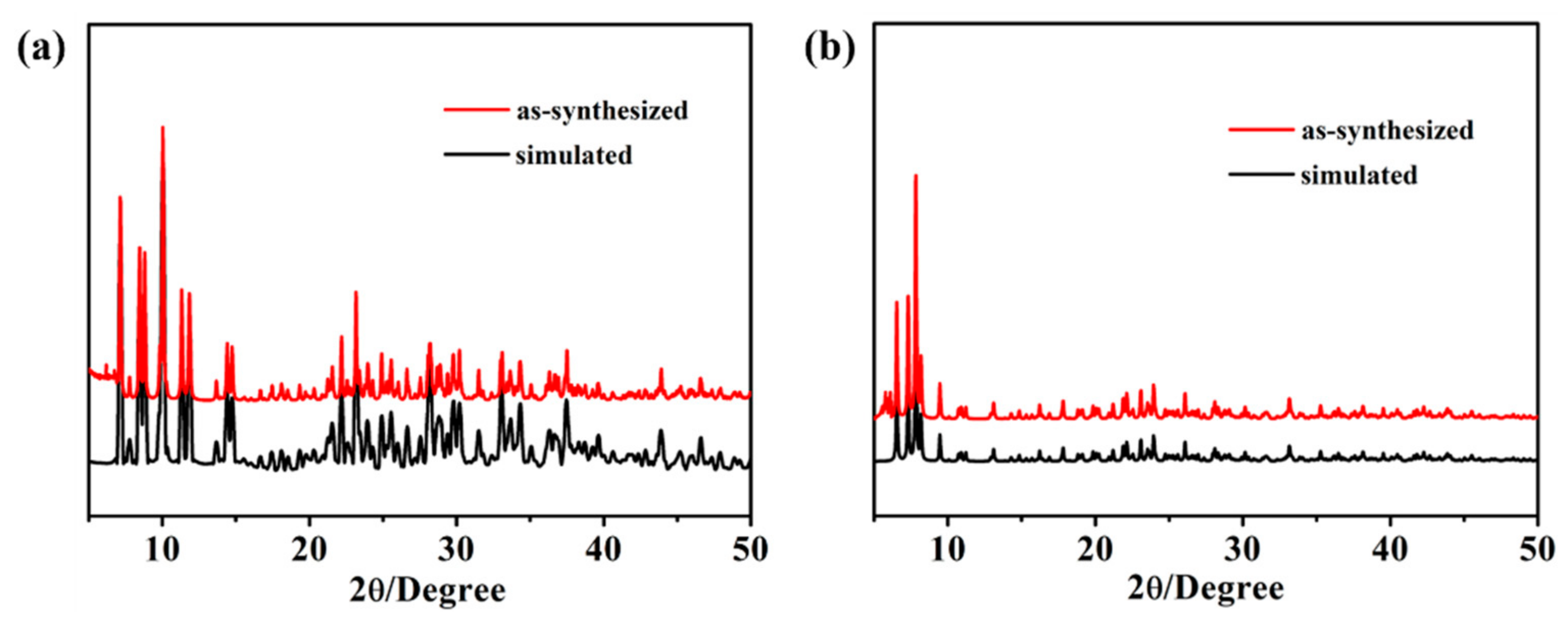
| Supramolecular Materials and Technologies | Various Research Results on the Degradation of Persistent Organic Pollutants |
|---|---|
| The supercapacitor and photocatalytic supermolecule materials constructed by 4′4-pyridine and {PMo12O40} | Zhang et al. reported that the photocatalytic supramolecular material had a good photocatalytic degradation effect on methylene blue (95.8%) and rhodamine B (93.54%) [54]. |
| Photocatalytically Active Supramolecular Organic–Inorganic Magnetic Composites | Sabina et al. prepared composites containing Zn-modified MgAl LDHs and Cu-phthalocyanine as a photosensitizer, which could remove up to 93% of β-lacamide antibiotics from water [55]. |
| AgI/BiPO4 n–n heterojunction photocatalyst | Zhou et al. prepared AgI/BiPO4 n-n heterojunction hybrid by precipitation technology. As a catalyst, the degradation efficiency of this substance for tetracycline hydrochloride (TC) was 95% and methylene blue (MB) was 91%, respectively [56]. |
| Supramolecular photocatalyst of perylene bisimide decorated with α-Fe2O3 | Lu et al. prepared α-Fe2O3/PTCDI composite based on supramolecular photocatalyst (PTCDI) modified dinaphthalenediamine (PTCDI) by calcination of ferric nitrate. The degradation rates of phenol pollutants and coking wastewater reached 73% and 66.7%, respectively, by photofenton reaction [57]. |
| Supramolecular Nanopumps with Chiral | Bao et al. prepared ph-responsive supramolecular nanopumps from porous tubules in the left hand to solid fibers in the right hand by self-assembly of aromatic amphiphiles with curved shapes. This superhydrophobic switching aromatic pore is ideal for effective removal and controlled release of organic pollutants from water through pulsating motion. It was found that the removal efficiency of the supramolecular compound was 78% for estradiol and 82% for bisphenol [58]. |
| Two new supramolecular materials {[(L1)·(Ag4I7)]CH3CN} (1), {[(L2)·(Ag4I7)]CH3CN} (2) were synthesized by templatedself-assembly of tetracations L1 and L2 with AgI at room temperature | In this paper the degradation rate of TC by 1 can reach 97.91%. |
| Treatment System | Catalytic Efficacy of the Catalysts on the TC |
|---|---|
| Floatable cellulose acetate beads embedded with flower-like zwitterionic binary MOF/PDA | Cao et al. combined SnS2 nanoparticles (SnSPs), a semiconductor material used for the photodegradation of antibiotics, onto the surface of a zirconia-based organic framework (UiO-66) to obtain a novel photocatalytic material with a degradation rate of 90% for TC [60]. |
| TiO2/Ag3PO4 nanojunctions on carbon fiber cloth | Eman et al. prepared the zwitterionic UiO-66/ZIF-8 binary MOF/polydopamine@cellulose acetate composite (UiO-66/ZIF-8/PDA@CA), the maximum removal rate of TC was 67% [61]. |
| MXene-Based Photocatalysts | Zhang et al. constructed TiO2/Ag3PO4 nanojunction on carbon fiber cloth, and the removal rate of TC from mobile wastewater reached 94.2% [62]. |
| Ag3PO4/GO | Wu et al. prepared Ag3PO4/GO catalyst by ultrasonic reaction, and after 30 min irradiation, the degradation rate of Ag3PO4/5wt%GO to TC was 77.7% [63]. |
| Enhanced sonochemical degradation of tetracycline by sulfate radicals. | Eslami et al. investigated the degradation of antibiotic TC in aqueous solution by silver-activated persulfate (Na2S2O8) in the presence of ultrasonic radiation. Under optimal conditions, a TC removal rate of more than 83% was achieved in 120 min [64]. |
| Facet-controlled activation of persulfate by magnetite nanoparticles | Hu et al. synthesized three magnetite nanoparticles (MNPs) with different bare crystal faces by hydrothermal method, and under heterogeneous activation of persulfate (PS), the degradation efficiency of the PS/MNPs {1 1 1} system for TC reached 74.38% within 4 h, which was much higher than that of the PS/MNPs {1 1 0} (19.29%) or PS/MNPs {1 0 0} (33.79%) systems [65]. |
| A yolk-shell Bi@void@SnO2 photocatalyst | Wu et al. synthesized the yolk-shell Bi@void@SnO2 photocatalyst by a step-by-step method, and its catalytic degradation efficiency of TC reached 81.81% [66]. |
| Two new supramolecular materials synthesized by templatedself-assembly of tetracations L1 and L2 with AgI | In this paper the degradation rate of TC by 1 can reach 97.91%. |
Publisher’s Note: MDPI stays neutral with regard to jurisdictional claims in published maps and institutional affiliations. |
© 2022 by the authors. Licensee MDPI, Basel, Switzerland. This article is an open access article distributed under the terms and conditions of the Creative Commons Attribution (CC BY) license (https://creativecommons.org/licenses/by/4.0/).
Share and Cite
Zhang, X.-X.; Wang, X.-J.; Niu, Y.-Y. Photocatalytic Degradation of Tetracycline by Supramolecular Materials Constructed with Organic Cations and Silver Iodide. Catalysts 2022, 12, 1581. https://doi.org/10.3390/catal12121581
Zhang X-X, Wang X-J, Niu Y-Y. Photocatalytic Degradation of Tetracycline by Supramolecular Materials Constructed with Organic Cations and Silver Iodide. Catalysts. 2022; 12(12):1581. https://doi.org/10.3390/catal12121581
Chicago/Turabian StyleZhang, Xing-Xing, Xiao-Jia Wang, and Yun-Yin Niu. 2022. "Photocatalytic Degradation of Tetracycline by Supramolecular Materials Constructed with Organic Cations and Silver Iodide" Catalysts 12, no. 12: 1581. https://doi.org/10.3390/catal12121581
APA StyleZhang, X.-X., Wang, X.-J., & Niu, Y.-Y. (2022). Photocatalytic Degradation of Tetracycline by Supramolecular Materials Constructed with Organic Cations and Silver Iodide. Catalysts, 12(12), 1581. https://doi.org/10.3390/catal12121581







